buy gabapentin 300mg uk After a late night were hanging out having coffee. Â My plan is to make us an omelet forlunch maybe with mushrooms and onions, however, I suspect Pat will want her’s a’ Nature.
Its beginning to rain outside so we may head for a museum, perhaps the Musée Nissim de Camondo which we have not been to for several years and it is always being restored.
Barka Kāna One of the most sumptuous private homes from the early twentieth century in Paris
Moïse de Camondo, a reputed Parisian banker during the Belle Epoque, was a passionate collector of French furniture and art objects from the eighteenth century, ans he amassed a collection of unusual quality. In 1911, he hired architect René Sergent to build a private mansion next to Parc Monceau that would be worthy of this collection and suitable for his family. The design was modeled after that of the Petit Trianon in Versailles, but behind the handsome décor of wood-paneled apartments were hidden the accoutrements of modern life, including kitchens, offices and bathrooms. The home, which is fully preserved in its original condition, offers an opportunity to discover the taste of a great collector and to get a glimpse of the everyday life of an aristocratic home.
The facade of the Nissim de Camondo Museum, located on an elegant residential street near Parc Monceau, was inspired by the Petit Trianon at Versailles. This urban townhouse mansion is furnished with the finest in 18th century decorative arts: paintings, furniture, tapestries, etc.
But all the finery and elegance could not protect its former occupants from a tragic fate. The house and it’s contents were willed to the Musee Arts Decoratifs in Paris in 1933 by Moise de Camondo, in memory of his son, Nissim, an aviator killed in aerial combat in 1917. Moise’s daughter, Beatrice and her family, the last descendants of Moise, were deported by the Germans in 1943 and perished at Auschwitz.
The mansion appears that the family just walked out the door, each of the rooms is exquisitely decorated. It’s collections are often considered to be on a par with the Frick Collection in NYC. From a chandelier with goose-egg size drops of
amethyst, rock crystal, and smokey quartz to its vast collection of Sevres, Meissen, and Chantilly porcelain, the rooms can be overwhelming and it’s easy to miss important objets d’art collected by Moise de Camondo, throughout his life.We finally pieced together the story of Moise de Camondo, the great grandson of a devout Sephardic Jew who headed a large family bank. Moise was born in Constantinople in 1860, moved with his father and uncle to Paris when they were establishing a
branch of the family bank. Both brothers died in 1889, after each purchased property on the Monceau plain and, after developing their business to a very prosperous bank. In fact they had been known as “the Rothschilds of the East.” Moise’s cousin, Isaac, took over the bank and his father’s property and continued to develop and collect according to his eclectic tastes from 18th-century furniture to Impressionist art. Isaac died in 1911 and his brother Moise took over business interests of the bank. Upon Isaac’s death, his art collection was was left to France and can be found in the Louvre and Musee des Arts Decoratifs.
Meanwhile, back at 63 rue de Monceau (the site of the current museum), Moise inherited the Hotel Violet from his mother when she died in 1910. Moise demolished the structure at 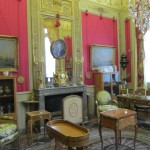 the end of the year and replaced it with a Petit-Trianon inspired mansion. The architect was forced to work around antique wainscoting and other items Moise had purchased, in addition to his vast collection of 18th century art, tapestries, rugs, furniture, porcelain, and collectibles.
the end of the year and replaced it with a Petit-Trianon inspired mansion. The architect was forced to work around antique wainscoting and other items Moise had purchased, in addition to his vast collection of 18th century art, tapestries, rugs, furniture, porcelain, and collectibles.
Moise finally took up residence with his children, Nissim and Beatrice, about the beginning of WWI. Moise and his wife, Irene Cahen d’Anvers, had divorced in 1901. Nissim had entered France’s defense forces as a lieutenant pilot and was killed in aerial combat in September 1917 and was posthumously awarded the Legion d’Honneur. Â Nissim was the intended heir of both the home, its vast collections, and the 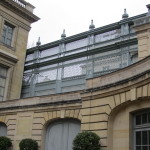 bank. The bank permanently closed after Nissim’s death.
bank. The bank permanently closed after Nissim’s death.
In 1933, Moise bequeathed his townhouse and collections to the state in order to preserve them in the honor and memory of his son, Nissim de Camondo. Moise, himself died in 1935. Nissim’s sister, Beatrice had married and had a son and daughter. In 1943, she and her family were arrested and sent to Auschwitz where they perished – the last descendants of the de Camondo clan.
The museum’s interior arrangement is very close to as it appeared at Moise’s death. In fact, in early 1936 photographs were taken of each room to document the items and their position. These photos are on display in one of the upstairs rooms. The chandeliers and woodwork details are gorgeous. Window treatments, wall treatments, upholstery, rugs, and the porcelain cabinet are over-the-top. There are clocks and barometers in every room. Rooms are designed on axis to take advantage of the views of Parc Monceau.


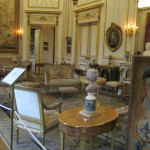
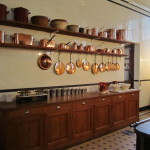
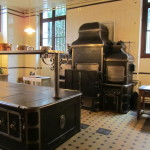

2 Responses to Paris Day 16 (Museum)